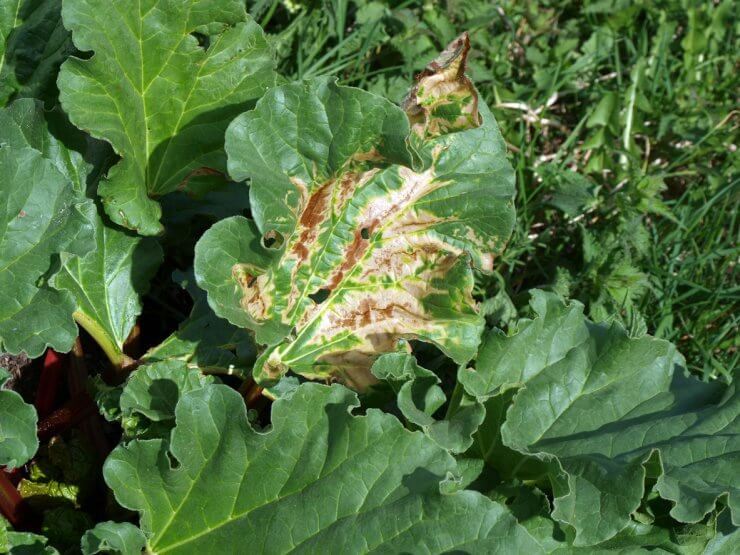
Diseased rhubarb leaves
Thankfully, rhubarb is one of those plants that is not especially prone to disease. While there are a few diseases that might plague your rhubarb plants, you should be able to deal with them easily if you spot them in time. This is especially important, as there are no fungicides approved for home use for many diseases.
These best practices are aimed at producing strong, healthy plants that can withstand disease, and at avoiding situations that contribute to the development of disease. They involve keeping plants clean, dry, and undamaged.
Companion Planting: Each crop has a garden buddy that helps out in some way: repelling pests, attracting pollinators, contributing nutrients to the soil. We discuss this in more detail in the Planting section of this collection. You can also review our Food Gardening Network Companion Planting Chart for a full list of good planting partners for your garden.
Mulch: Mulch can help with water retention—but be vigilant and check for insect or fungal activity. Keep mulch away from the crown of the plant and away from the base of the stalks.
Watering: Water your rhubarb deeply about once a week (check the soil for dryness). Do not over-water. Soggy soil invites disease.
Other best practices include:
- Buy healthy, disease-free seeds or crowns from reputable sources.
- Plant your rhubarb in full sun.
- Plant in sites with good drainage; if planting in open ground, choose a higher spot for better drainage.
- Check plants regularly for signs of disease.
Common Rhubarb diseases
Here are some of the usual culprits that might infest your rhubarb plants. Remember, it’s important to remove infected plant material (leaves, roots) to prevent the spread of disease once it’s found its way onto your plant.
Rhubarb Viruses
Viruses occasionally infect rhubarb, but not especially often; they include turnip mosaic, Arabic mosaic, and cherry leaf roll viruses. Symptoms include mottling on the leaves and ring-shaped spots. These viruses are most commonly found on infected planting stock. Your best way to avoid these viruses is to buy your seeds or crowns from a reputable nursery. If your rhubarb plants get infected, the best course of action is to dig up and destroy infected plants, and remove and destroy any neighboring weeds—just in case they are also infected.
Most other rhubarb infections, as you’ll see, come from fungi.
Ascochyta Leaf Spot
Cause: Fungus
Symptoms: ‘
- first appears as small, green-yellow, irregular spots less than a half inch in diameter on the leaf surface
- leaf develops a mosaic appearance as the lesions come together
- spots develop white centers with reddish margins
- infected spots turn brown, die, and fall out, leaving holes in the leaves
- does not affect the stalks
How it Spreads:
- spores thrive in moist soil and cool temperatures
Treatment:
- liquid copper fungicide, if infection is severe
- remove and discard infected parts
Prevention:
- avoid planting in cool, wet weather
- plant in well-draining areas
- treat seeds with fungicides before planting
- use drip irrigation; avoid overhead watering
Ramularia Leaf Spot
Cause: Fungus
Symptoms:
- first appears as small red dots that enlarge to form circular lesions about a half inch across
- larger spots become white/tan with purplish halos
- larger spots turn white to tan, forming lesions on the stalks
- infected stalks have small spots that elongate as the stalk grows
- white fungus appears in the centers of spots on stalks and leaves, turning brown as the tissue dies
How it Spreads:
- spores thrive in moist soil and cool temperatures
Treatment:
- liquid copper fungicide, if infection is severe
- remove and discard infected parts
Prevention:
- avoid planting in cool, wet weather
- plant in well-draining areas
- treat seeds with fungicides before planting
- use drip irrigation; avoid overhead watering
Botrytis
Cause: Fungus
Symptoms:
- leaf, stalk, and crown rot (most often affects forced rhubarb)
How it Spreads:
- fungus overwinters in infected plant material
- rotting material near plants
- wind, insects, and birds
Treatment:
- remove and destroy infected plant parts
- apply fungicide at first notice
Prevention:
- liquid copper fungicide
- keep rotting material away from plants
- plant disease-resistant varieties
- remove plant debris
Root and Crown Rots
Cause: Fungi and bacteria
Symptoms:
- plants not thriving
- leaves turn yellow, then red, then collapse
- crowns exhibit black-brown decay
- large roots missing feeder roots
- larger roots have brown-black holes
How it Spreads:
- rain helps spread spores in temperatures between 65 to 75 degrees F
- overwatering can spur crown rot
Treatment:
- remove and discard infected material
Prevention:
- buy or acquire healthy plant stock
- plant rhubarb in well-drained soil
- remove and destroy infected plant material as soon as you discover it
- avoid planting in cool, wet weather
- avoid overhead watering; water at soil level
- make sure plants have good air circulation and lots of sun
Anthracnose Stalk Rot
Cause: Fungus
Symptoms:
- wilted leaves
- water-soaked lesions on the stalks
- lesions enlarge and turn black
- stalks may appear twisted, then collapse
How it Spreads:
- spores thrive in moist soil and cool temperatures
Treatment:
- remove and discard infected parts
Prevention:
- avoid planting in cool, wet weather
- plant in well-draining areas
- if starting from seed, treat seeds with fungicides before planting
- use drip irrigation; avoid overhead watering
- water early in the day to facilitate water evaporation from leaves
Which diseases have you had to treat on your rhubarb? Please tell us how you prevent and handle diseases. If you spot other symptoms on your rhubarb that are not mentioned here, contact your local extension center or garden center for a consult—and please let us know what you discover.


 Previous
Previous

